Stuckenia pectinata
Flora fur das deutsche Volk 713. 1912.
Stems branched, especially distally, terete to slightly compressed, to 75 cm. Leaves: those of main stem only slightly larger than those of branches; stipules with stipular sheaths not inflated, 0.8–1.1 cm, ligule 0.8 mm; blade linear, 5.6–9.2 cm × 0.2–1 mm, apex acute to mucronate or apiculate; veins 1–3. Inflorescences: peduncles terminal or axillary, erect to ascending, cylindric, 4.5–11.4 cm; spikes moniliform to cylindric, 14–22 mm; verticels 3–5. Fruits yellow-brown to brown, oblanceoloid, 3.8–4 × 2.5–3.1 mm; beak toward abaxial margin, erect, 0.5–1.1 mm. 2n = 78.
Phenology: Flowering summer–fall.
Habitat: Brackish to alkaline waters of lakes, streams, rivers, and estuaries
Elevation: 0–2400 m
Distribution

St. Pierre and Miquelon, Alta., B.C., Man., N.B., Nfld. and Labr. (Nfld.), N.W.T., N.S., Ont., P.E.I., Que., Sask., Yukon, Ala., Alaska, Ariz., Ark., Calif., Colo., Conn., Fla., Idaho, Ill., Ind., Iowa, Kans., Ky., La., Maine, Md., Mass., Mich., Minn., Mo., Mont., Nebr., Nev., N.H., N.J., N.Mex., N.Y., N.C., N.Dak., Ohio, Okla., Oreg., Pa., R.I., S.Dak., Tenn., Tex., Utah, Vt., Va., Wash., W.Va., Wis., Wyo., Mexico, Central America, South America, Eurasia, Australia.
Discussion
No specimens have been seen from Delaware, but the species is to be expected there.
The sago-pondweed is among the most important species as food for waterfowl (E. Moore 1913). The species reproduces vegetatively by underground tubers and is spread by various duck species, especially canvas backs. In a study of food for ducks, a population of canvas backs was observed feeding in aquatic vegetation comprised of several genera, including sago-pondweed. When the stomach contents were examined, they were found to contain essentially 100% tubers of sago-pondweed (E. Moore 1913).
Two hybrids with this species as a putative parent have been described under the genus Potamogeton. These are P. pectinatus × P. vaginatus (= P. × bottnicus Hagström) and P. filiformis × P. pectinatus (= P. × suecicus K. Richter).
Selected References
None.
